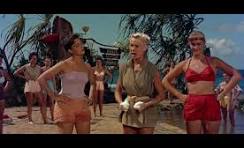Summary
The idea for the song came from Mary Martin herself—she suggested incorporating an actual hair-washing moment during the performance, which Rodgers and Hammerstein embraced. This playful, upbeat number became an anthem of independence and empowerment, symbolizing a woman’s decision to move on from a romantic relationship.
“I’m Gonna Wash That Man Right Outa My Hair
https://www.youtube.com/watch?v=qr3wH4u4xus
The song “I’m Gonna Wash That Man Right Outa My Hair” originated in the 1949 Broadway musical South Pacific, written by Richard Rodgers (composer) and Oscar Hammerstein II (lyricist). It was performed by the character Nellie Forbush, initially played by Mary Martin, in a memorable scene where she literally washes her hair on stage while singing the tune.
The idea for the song came from Mary Martin herself—she suggested incorporating an actual hair-washing moment during the performance, which Rodgers and Hammerstein embraced. This playful, upbeat number became an anthem of independence and empowerment, symbolizing a woman’s decision to move on from a romantic relationship.
The song later appeared in the 1958 film adaptation of South Pacific and has since become a standard in the American Songbook, referenced in pop culture and even adapted for advertising campaigns (like Clairol’s “I’m gonna wash that gray right outta my hair” in the 1980s).
The lyrics for “I’m Gonna Wash That Man Right Outa My Hair” were inspired by an idea Mary Martin, the original Nellie Forbush in South Pacific, suggested. During rehearsals, Martin proposed that she could actually wash her hair on stage during the song to make the scene more dynamic and believable. Rodgers and Hammerstein loved the concept and wrote the lyrics around that action, symbolizing a woman’s determination to cleanse herself emotionally and physically from a romantic entanglement.
The playful metaphor of “washing a man out of your hair” perfectly fits the character’s spirited personality and the theme of independence. It became one of the musical’s most iconic numbers.
Here’s a short cultural analysis of why “I’m Gunna Wash That Man Right Outa My Hair” resonated with audiences in the post-WWII era:
Cultural Impact
When South Pacific debuted in 1949, America was transitioning from wartime austerity to a period of optimism and independence. Women who had worked during the war were negotiating new roles in society, and themes of autonomy and self-determination were gaining traction. The song’s playful metaphor—literally washing away a romantic entanglement—captured this spirit perfectly. It suggested that women could take control of their emotional lives, a progressive idea for its time.
The scene was also visually striking: Nellie Forbush washing her hair on stage while singing became a symbol of liberation and practicality. This combination of humor, empowerment, and theatrical realism made the number unforgettable.
Modern References
The song’s influence extended far beyond Broadway:
- Advertising: Clairol famously adapted the lyric for its “I’m gonna wash that gray right outta my hair” campaign in the 1980s.
- Pop Culture: It’s been referenced in TV shows, films, and even parodies, cementing its place as an idiom for moving on.
Here’s a timeline of adaptations and cultural references for the song
1949 – Original Broadway Debut
- Featured in South Pacific by Rodgers & Hammerstein.
- Performed by Mary Martin as Nellie Forbush, washing her hair on stage—a groundbreaking theatrical moment.
1958 – Film Adaptation
- Included in the movie version of South Pacific, sung by Mitzi Gaynor.
- Cemented the song as a pop culture staple.
1960s–1970s – Television & Variety Shows
- Frequently performed in musical specials and variety programs.
- Became a shorthand for independence and moving on.
1980s – Advertising Adaptation
- Clairol launched its famous campaign:
“I’m gonna wash that gray right outta my hair.” - This clever twist linked the song to beauty and self-care.
1990s–2000s – Pop Culture References
- Referenced in sitcoms, films, and parodies as an idiom for starting fresh.
- Appeared in musical revivals and tribute performances.
2010s–Present – Legacy
- Continues to be used in stage revivals of South Pacific.
- Quoted in articles, blogs, and even motivational contexts as a metaphor for empowerment.
